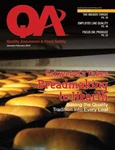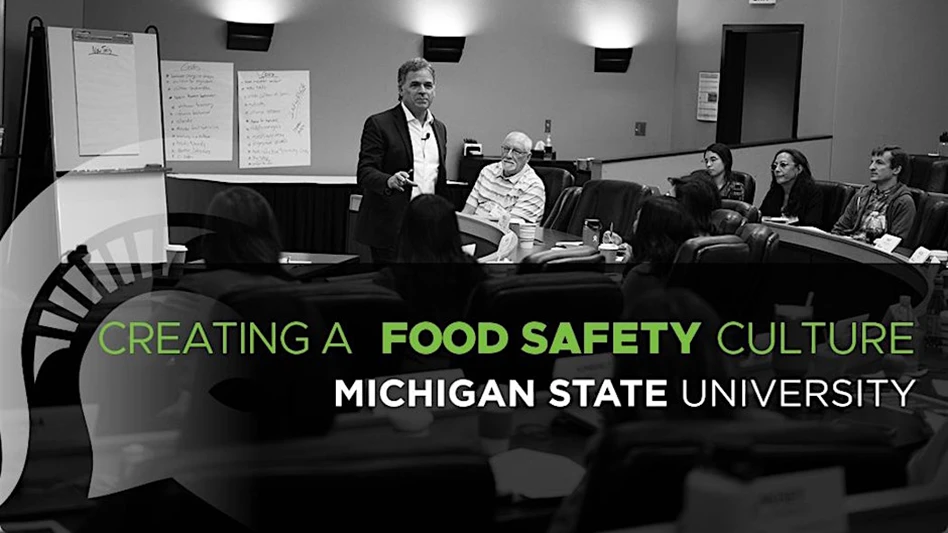U.S. Marshals seized more than $1 million in food from a Nashville food processor and warehouse, after FDA found evidence of an active and widespread rodent infestation, including live and dead rodents, rodent urine, hair, nesting material and gnawed food. Investigators also observed insect filth, live birds, and building defects that could allow pests to enter food storage areas. The unsanitary conditions and practices by which food can become contaminated denote the products as adulterated under the Federal Food, Drug and Cosmetic Act.
"The violations at Won Feng Trading are both serious and repetitive," said Michael Chappell, the FDA’s acting associate commissioner for regulatory affairs. "The FDA will take actions against any food companies that fail to provide adequate safeguards to ensure that products they produce or hold for sale remain free of contamination."
"In the big picture of quality assurance, pest management is one piece of the pie. Until something happens—then it is the whole pie," said Greg Baumann, Vice President of Technical Services for the National Pest Management Association (NPMA). Baumann was a quality assurance manager at Hershey Foods prior to joining the pest management industry. Of all the responsibilities he held as QA manager, he said, "on my list of worries, pest management was at the bottom."
Not because it couldn’t cause problems, but because the plant had a strong pest man-agement program in place. "It is one thing you can deal with and not worry about," Baumann said, as long as your program includes ongoing, thorough inspection along with prevention and treatment.
In contrast, the lack of a good pest management program can lead to a QA manager’s greatest worries and problems. And very often, problems in pest management and sanitation go hand in hand.
Inspector findings. As an inspector for the state of New York for almost 40 years, Joe Corby saw this first hand. "You could almost tell before you even started an inspection if the establishment would have a problem," Corby said
If he'd see garbage strewn across the lot, overloaded dumpsters, weeds running rampant … it was fairly obvious what would be found inside the plant, he said. "We haven’t even introduced ourselves and we’re already setting the tone of the inspection. Generally it is pretty accurate."
In New York, where an infestation is an automatic failure with action taken against the establishment, Corby said, "If we find an infestation in an area we believe food or equipment could be contaminated, it is a critical violation. We consider those crea-tures to be public health hazards because of the illness they can carry and the organ-isms they can transmit."
While there is not always evidence to specifically implicate pests in food-contamination recalls, they can often be corroborated as a contributing factor. Baumann noted the PCA peanut-product recall as an example. With the extent of problems in PCA’s processes, there was not enough evidence to pinpoint a precise cause of the Salmonella contamination. But unsanitary conditions attract and breed pests and, in turn, those pests can track and transmit microbes across food products and equipment.
"You can’t say the root cause was the rodent infestation, but that was icing on the cake" and a final straw in the inspection, Baumann said. "There’s a reason that pests are prohibited in plants. That points to exactly why."
Pests as carriers. In fact, said Dan Collins, president of Collins Pest Man-agement, "house mice are one of the most overlooked pests in the food industry."
Although rodent stations are set and checked, it is critical that inspections be a prominent part of every service as well. "You have to have time built in to go beyond the traps into inspection," he said. This is because a single house mouse can leave 50-75 pellets and 3,000 micro-droplets of urine in its tracks each day. Besides the disease it can directly transmit, it can track virtually any microorganism from one place to another.
"Every pest carries some opportunity to introduce disease into an environment," said Deni Naumann, president of Copesan Services. In fact, she added, "Other than human hygiene issues, pest management would probably be the next biggest issue on how you can have critical failures."
It is an area which QA managers need to address in partnership with their pest management provider, Naumann said. And the focus should encompass not only pest pressures, but also sanitation and structural deficiencies. "Quality assurance managers don’t want to have to worry about pest management—about whether or not the bait stations are full or the pest management company is doing the right things."
The key to doing the right things, she said, is focusing on the critical, vulnerable areas in a facility, including entry points and sanitation. If a plant is not cleaned, it is very difficult to provide pest management. "If it is cleaned up regularly, pest management issues would go down."
*****
Quotable Quotes from the Experts
"They wind up costing themselves more money in the end."
Joe Corby, retired Food Inspector for the state of New York, explaining what generally happens when a company tries to save money by doing its own pest management in-house without having a trained, certified technician. Although he has seen problems in large plants, the bigger issues were generally seen in the smaller establishments. "Clearly smaller plants operate on a smaller dime and often try to do it themselves. That’s when there are problems," he said. "We just think education is so very important—so that they know they need professional help."
*****
"The average consumer will accept some risk of microbes [in food], but will you accept a dead mouse being in there?"
Greg Baumann, vice president of technical services for the National Pest Management Association (NPMA), noting that consumers are often appalled to discover that there are federal tolerance levels for pest parts and fragments in food. "The consumer will, to a certain degree, tolerate microbial contamination. But they are not tolerant at all about any type of pest." Nor are regulators, inspectors or auditors—or consumers—tolerant of pests within the plant or their threat to food safety. "The pest management industry is an important part of food protection without a doubt." And its importance has increased in recent years with the dissemination and growing acceptance of NPMA’s Pest Management Standards for Food Plants—acceptance not only by pest management professionals and food plants, but also by auditing agencies and, most recently, GFSI. The standards can be ordered at www.pctonline.com/store.
*****
"When cockroaches can go that far, it just increases the likelihood that they will travel to a spot that is unsanitary."
Gordon Morrison, product marketing manager for Bayer Environmental Science, noting the results of studies in apartment buildings that have shown that cockroaches will travel across four apartments to find food. "They tend to go as far as they need to go for food, water and shelter," he said, explaining that even a single unsanitary area in a plant can support pests. "The cleaner the area, the more they get around."
*****
"You can have too much focus on the wrong thing."
Dan Collins, president of Collins Pest Management, discussing the importance of both pest management professionals and plant personnel understanding the risk factors and pest contributors specific to each 'plant. What raw ingredients are most at risk for infestation? Are the right number of baits stations and traps set in the right place—or are there more than needed, taking the technician's focus away from inspection? Do employees understand the need to report sightings immediately and keep doors closed—or do they need education on pests? And, of great importance, Collins said, does plant management buy in? "They have to say this is a priority and they will do the things needed to reduce pest activity."
*****
Establishing a partnership. William Kolbe, market development special-ist for BASF Pest Control Solutions, agreed that pest management professionals and food plant personnel need to partner in a common goal toward a pest-free food plant. "The ongoing changes in food safety demand that pest management professionals that provide Integrated Pest Management (IPM) in your plant are up to date in all food safety initiatives," Kolbe said. "With all the emphasis on food safety and the current Global Food Safety Initiative, pest man-agement is a crucial part of the food plant’s food safety program."
Forming a partnership means making the pest management technician a part of the internal team. "It is paramount to have ongoing meetings with key food plant personnel and pest management personnel to constantly evaluate, monitor and change or adjust the IPM program," Kolbe said. As such, a key initiative may be to have the technician sit in on in-house sanitation and quality assurance training. "The technician should know your plant inside and out in order to provide the highest level of pest prevention and pest management."
When Collins sets up a pest management plan in a food plant, he said he makes one common request: "Give me the top five areas in your plant that are the hardest to clean. That’s where I will start my inspection. That’s where you will find pests or pest contributors." This is because in almost any plant, he said, "Twenty percent of the facility is contributing 80 percent of the pest issues."
Insect threats. Gordon Morrison, product marketing manager for Bayer Environmental Science, has seen cockroaches as the greatest insect threat to plants. "When it comes to insects, it’s all about the cockroaches. Cockroaches are the ones that transmit food poisoning, Salmonella and such."
While stored product pests are a huge issue in their infesting of stored products, he said, disease is not really associated with those pests. Cockroaches, however, will walk through unsanitary areas and pick up contaminants on their "feet" and bodies, then track these onto foods and food equipment. "So the better the sanitation, the less likely you are to move pathogens from one area to another."
Pest management in plants comes down to two issues, Baumann said, regulatory—by which the regulations are very clear on adulterated products; and product integrity—which puts a company’s liability and reputation on the line. And often, the impact to a company’s reputation is more expensive and destructive than a regulatory penalty. Again noting PCA, he said, "their reputation is shot." Even if the regulatory agency hadn’t been involved, the nega-tive publicity would have caused the company to cease to exist.
Corby sees today’s pest management programs as better than those of the past, as there is now emphasis placed on inspection rather than simply spraying and baiting. "I’ve seen it so many times when they would just come in and bait. It’s just not that effective."
When an inspection did reveal critical violations, a facility would often call a professional pest company to "wave a magic wand and get rid of the pests," he said. "You can’t wait until it gets that far. You have to have operational and environmental controls all along."
The author is Managing Editor of QA magazine. She can be reached at llupo@giemedia.com.

Explore the February 2010 Issue
Check out more from this issue and find your next story to read.
Latest from Quality Assurance & Food Safety
- Calbee America Launches California R&D Innovation Center
- PepsiCo Completes Acquisition of Siete Foods
- Non-GMO Project Launches Non-Ultraprocessed Foods Verification
- FDA to Hold Webinar on Updated ‘Healthy’ Claim
- High-Tech Partnership Creates Natural Blue Color for Greener Tomorrow
- Kraft Heinz Hosts Innovation Challenge for Sustainable Packaging
- FDA Requests Information on Poppy Seeds
- Danone North America Opens Applications for Annual Gut Microbiome, Yogurt and Probiotics Fellowship Grant





